The Mode Dial
Press the mode dial lock release and rotate the mode dial to choose from the following modes:
Mode dial
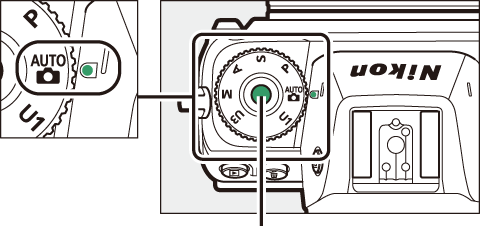
Mode dial lock release
- b Auto: A “point-and-shoot” mode in which the camera sets exposure and hue (0 Taking Photographs (b Mode), Shooting Movies (b Mode)).
- P Programmed auto: The camera sets shutter speed and aperture for optimal exposure. Recommended for snapshots and in other situations in which there is little time to adjust camera settings.
- S Shutter-priority auto: You choose the shutter speed; the camera selects the aperture for best results. Use to freeze or blur motion.
- A Aperture-priority auto: You choose the aperture; the camera selects the shutter speed for best results. Use to blur backgrounds or bring both foreground and background into focus.
- M Manual: You control both shutter speed and aperture. Set shutter speed to “bulb” or “time” for long time-exposures.
- U1, U2, U3 User settings modes: Assign frequently-used settings to these positions for quick recall.
- P: Programmed Auto
- S: Shutter-Priority Auto
- A: Aperture-Priority Auto
- M: Manual
- User Settings: U1, U2, and U3 Modes
- Long Time-Exposures (Mode M)
P: Programmed Auto
In this mode, the camera automatically adjusts shutter speed and aperture according to a built-in program to ensure optimal exposure in most situations. Different combinations of shutter speed and aperture that produce the same exposure can be selected by rotating the main command dial (“flexible program”). While flexible program is in effect, a flexible program indicator (U) is displayed. To restore default shutter speed and aperture settings, rotate the main command dial until the indicator is no longer displayed, choose another mode, or turn the camera off.
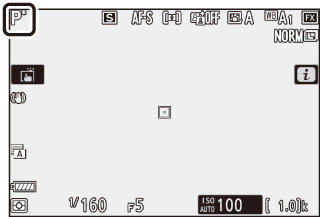
S: Shutter-Priority Auto
In shutter-priority auto, you choose the shutter speed while the camera automatically selects the aperture that will produce the optimal exposure. To choose a shutter speed, rotate the main command dial. Shutter speed can be set to “×200” or to values between 30 s and 1/8000 s and can be locked at the selected setting (0 f4: Shutter Spd & Aperture Lock).

Monitor
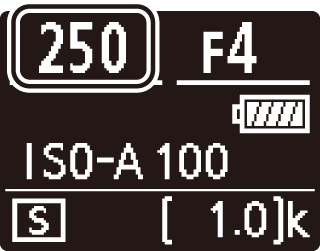
Control panel
A: Aperture-Priority Auto
In aperture-priority auto, you choose the aperture while the camera automatically selects the shutter speed that will produce the optimal exposure. To choose an aperture between the minimum and maximum values for the lens, rotate the sub-command dial. Aperture can be locked at the selected setting (0 f4: Shutter Spd & Aperture Lock).
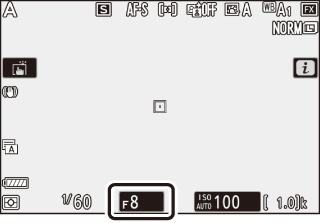
Monitor
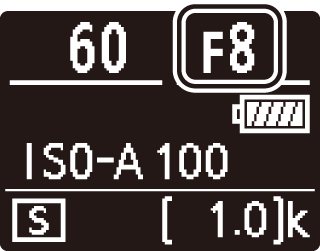
Control panel
Movie Mode Exposure Settings
The following exposure settings can be adjusted in movie mode:
| Aperture | Shutter speed | ISO sensitivity | |
|---|---|---|---|
| P, S 1 | ー | ー | ー 2, 3 |
| A | ー | ー 2, 3 | |
| M | 3, 4 |
Exposure for mode S is equivalent to mode P.
The upper limit for ISO sensitivity can be selected using the ISO sensitivity settings > Maximum sensitivity option in the movie shooting menu.
Regardless of the option chosen for ISO sensitivity settings > Maximum sensitivity or for ISO sensitivity (mode M), the upper limit when On is selected for Electronic VR in the movie shooting menu is ISO 25600 (Z 7) or 51200 (Z 6).
If On is selected for ISO sensitivity settings > Auto ISO control (mode M) in the movie shooting menu, the upper limit for ISO sensitivity can be selected using the Maximum sensitivity option.
M: Manual
In manual exposure mode, you control both shutter speed and aperture. Rotate the main command dial to choose a shutter speed, and the sub-command dial to set aperture. Shutter speed can be set to “×200” or to values between 30 s and 1/8000 s, or the shutter can be held open indefinitely for a long time-exposure (0 Long Time-Exposures (Mode M)). Aperture can be set to values between the minimum and maximum values for the lens. Use the exposure indicators to check exposure.
Monitor
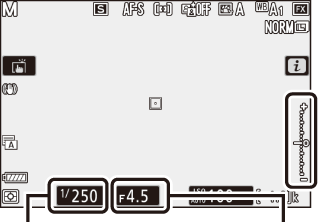
Shutter speed
Aperture
Control panel
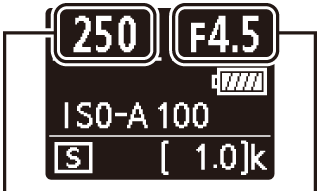
Shutter speed
Aperture
Shutter speed and aperture can be locked at the selected settings.
Exposure Indicators
The exposure indicators show whether the photograph would be under- or over-exposed at current settings. Depending on the option chosen for Custom Setting b1 (EV steps for exposure cntrl), the amount of under- or overexposure is shown in increments of 1/3 or 1/2 EV. If the limits of the exposure metering system are exceeded, the displays will flash.
| Custom Setting b1 set to “1/3 step” | |||
|---|---|---|---|
| Optimal exposure | Underexposed by 1/3 EV |
Overexposed by over 3 EV |
|
| Monitor |  |
 |
 |
| Viewfinder |  |
 |
 |
Auto ISO Sensitivity Control (Mode M)
If auto ISO sensitivity control (0 Auto ISO Sensitivity Control) is enabled, ISO sensitivity will automatically be adjusted for optimal exposure at the selected shutter speed and aperture.
User Settings: U1, U2, and U3 Modes
Assign frequently-used settings to the U1, U2, and U3 positions on the mode dial.
Saving User Settings
Follow the steps below to save settings:
-
Select a mode.
Rotate the mode dial to the desired mode.

-
Adjust settings.
Make the desired adjustments to camera settings, including:
- photo shooting menu options,
- movie shooting menu options,
- Custom Settings, and
- shooting mode, shutter speed (modes S and M), aperture (modes A and M), flexible program (mode P), exposure compensation, and flash compensation.
-
Select Save user settings.
Highlight Save user settings in the setup menu and press 2.
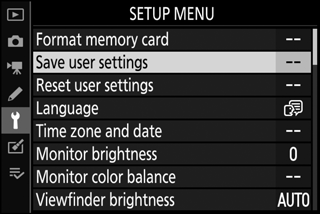
-
Select a position.
Highlight Save to U1, Save to U2, or Save to U3 and press 2.
-
Save user settings.
Highlight Save settings and press J to assign the settings selected in Steps 1 and 2 to the mode dial position selected in Step 4.
Recalling User Settings
Rotating the mode dial to U1, U2, or U3 recalls the settings last saved to that position.
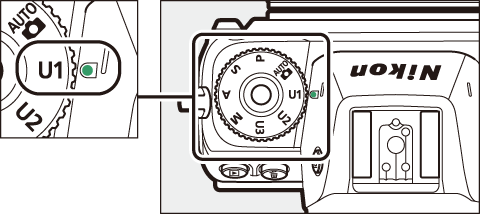
Resetting User Settings
To reset settings for U1, U2, or U3 to default values:
-
Select Reset user settings.
Highlight Reset user settings in the setup menu and press 2.
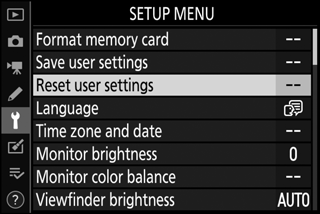
-
Select a position.
Highlight Reset U1, Reset U2, or Reset U3 and press 2.
-
Reset user settings.
Highlight Reset and press J to restore default settings for the selected position. The camera will function in mode P.
User Settings U1, U2, and U3
The release mode is not saved. In addition, the following settings are not saved.
Photo shooting menu:
- Storage folder
- Choose image area
- Manage Picture Control
- Multiple exposure
- Interval timer shooting
- Time-lapse movie
- Focus shift shooting
Movie shooting menu:
- Choose image area
- Manage Picture Control
Long Time-Exposures (Mode M)
Select the following shutter speeds for long time-exposures of moving lights, the stars, night scenery, or fireworks.

- Shutter speed: Bulb (35-second exposure)
- Aperture: f/25
- Bulb: The shutter remains open while the shutter-release button is held down.
- Time: The exposure starts when the shutter-release button is pressed and ends when the button is pressed a second time.
To prevent blur, mount the camera on a tripod or use an optional wireless remote controller, remote cord, or other remote release device. Nikon also recommends using a fully-charged battery or an optional AC adapter and power connector to prevent loss of power while the shutter is open. Note that noise (bright spots, randomly-spaced bright pixels, or fog) may be present in long exposures. Bright spots and fog can be reduced by choosing On for Long exposure NR in the photo shooting menu.
-
Ready the camera.
Mount the camera on a tripod or place it on a stable, level surface.
-
Select mode M.
Rotate the mode dial to M.
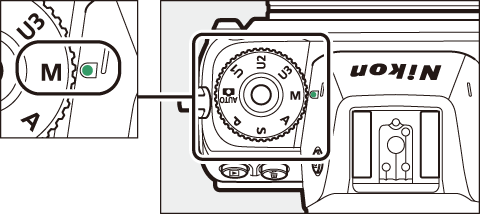
-
Choose a shutter speed.
Rotate the main command dial to choose a shutter speed of Bulb or Time.
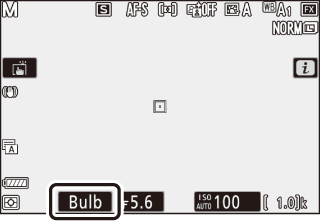
Bulb

Time
-
Open the shutter.
Bulb: After focusing, press the shutter-release button all the way down. Keep the shutter-release button pressed until the exposure is complete.
Time: Press the shutter-release button all the way down.
-
Close the shutter.
Bulb: Take your finger off the shutter-release button.
Time: Press the shutter-release button all the way down.
